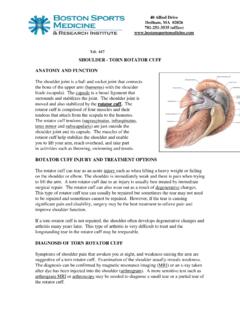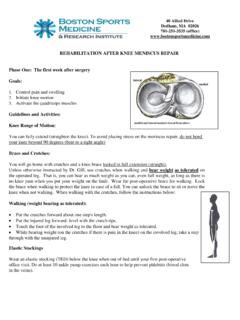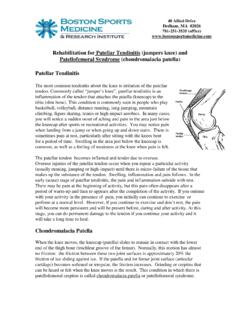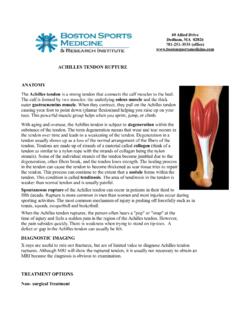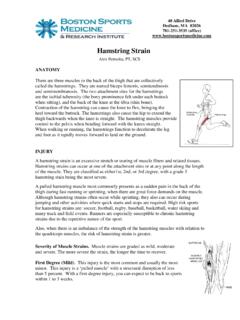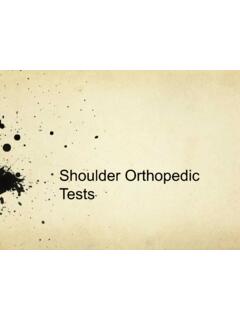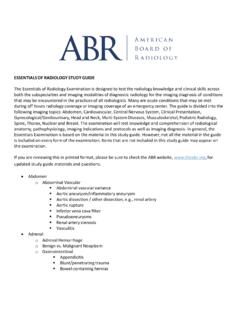Transcription of ARTHROSCOPIC LABRUM REPAIR
1 40 Allied Drive Dedham, MA 02026 781-251-3535 (office) ARTHROSCOPIC LABRUM REPAIR of the shoulder (SLAP) Anatomy The shoulder joint involves three bones: the scapula ( shoulder blade), the clavicle (collarbone) and the humerus (upper arm bone). The humeral head rests in a shallow socket on the scapula called the glenoid. Because the head of the humerus much larger than the glenoid, a soft fibrous tissue LABRUM called the LABRUM surrounds the glenoid to help deepen and stabilize the joint. The LABRUM deepens the glenoid by up to 50 percent so that the head of the humerus fits better. In addition, it serves as an attachment site for several ligaments. Injuries Injuries to the LABRUM can occur from acute trauma or repetitive shoulder motion. Examples of traumatic injury include: Falling on an outstretched arm Direct blow to the shoulder Sudden pull, such as when trying to lift a heavy object Forceful overhead motions Tears can be located either above (superior) or below (inferior) the middle of the glenoid.
2 A SLAP lesion (superior LABRUM , anterior [front] to posterior [back]) is a tear of the LABRUM above the middle of the glenoid that may also involve the biceps tendon. A tear of the LABRUM below the middle of the glenoid socket that also involves the inferior glenohumeral ligament is called a Bankart lesion. Tears of the glenoid LABRUM often occur with other shoulder injuries, such as a dislocated shoulder (full or partial dislocation ). Signs and symptoms 40 Allied Drive Dedham, MA 02026 781-251-3535 (office) It is difficult to diagnose a tear in the glenoid LABRUM because the symptoms are very similar to other shoulder injuries. Symptoms include: Pain, usually with overhead activities Catching, locking, popping or grinding Occasional night pain or pain with daily activities A sense of instability in the shoulder Decreased range of motion Loss of strength Treatment Until the final diagnosis is made, Dr.
3 Gill may prescribe anti-inflammatory medication and rest to relieve symptoms. Rehabilitation exercises to strengthen the rotator cuff muscles may also be recommended. If these conservative measures are insufficient, Dr. Gill may recommend ARTHROSCOPIC surgery. During the surgery, Dr. Gill will examine the LABRUM and the biceps tendon. If the injury is confined to the LABRUM itself, without involving the tendon, the biceps tendon attachment is still stable. Dr. Gill will remove the torn flap and correct any other associated problems. If the tear extends into the biceps tendon or if the tendon is detached, the result is an unstable biceps attachment. Dr. Gill will need to REPAIR and reattach the tendon, using suture anchoring devices. If there is a tear below the middle of the glenoid, Dr. Gill will reattach the ligament to the glenoid (Bankart REPAIR ). Rehabilitation After surgery, you will need to keep your shoulder in a sling for three to four weeks.
4 Dr. Gill will also prescribe gentle, passive range-of-motion exercises. When the sling is removed, you will need to do motion and flexibility exercises and eventually start strengthening. Athletes can usually begin doing sports-specific exercises after twelve weeks, although it will be about six months before the shoulder is fully healed. 40 Allied Drive Dedham, MA 02026 781-251-3535 (office) ARTHROSCOPIC Superior LABRUM anterior to Posterior (SLAP) REPAIR of the shoulder PREOPERATIVE INSTRUCTIONS Within one month before surgery - as indicated by your doctor. Preoperative office visit for history and physical examination and instructions Complete blood count (CBC) Electrocardiogram (EKG) if over the age of 40 Within several days before surgery Wash the shoulder and axilla well Be careful of the skin to avoid sunburn, poison ivy, etc. The day before surgery Check with Dr.
5 Gill s office for your time to report to the surgical unit the next day. HAVE NOTHING TO EAT OR DRINK AFTER MIDNIGHT. If surgery will be done in the afternoon, you can have clear liquids only up to six hours before surgery but no milk or food. The day of surgery Nothing to eat or drink Please bring the sling, ice machine and imaging studies that you may have received. 40 Allied Drive Dedham, MA 02026 781-251-3535 (office) Rehabilitation after ARTHROSCOPIC LABRUM REPAIR of the shoulder (SLAP) Phase 0: 0 to 2 weeks after surgery POSTOPERATIVE INSTRUCTIONS You will wake up in the operating room. A sling and an ice pack will e in place. You will go to the recovery room and generally will be discharged after 1-2 hours. You can get out of bed when you wish. Apply ice to the shoulder to reduce pain and swelling. You may remove the sling whenever you wish and gently move the elbow, wrist and fingers.
6 Follow Dr. Gill s instructions regarding moving your shoulder after surgery. GOALS: 1. Control pain and swelling 2. Protect the REPAIR 3. Begin early shoulder motion ACTIVITIES WHEN YOU GO HOME: 1. Apply ice to the shoulder as tolerated to reduce pain and swelling. You can change the dressing to a smaller one to allow the cold therapy to reach the shoulder . 2. Remove the sling on the first day after surgery. Move your elbow, fingers and hand several times a day. 3. Begin the pendulum exercise several times a day: Pendulum exercise Bend over at the waist and let the arm hang down. Using your body to initiate movement, swing the arm gently in small circular motions. Repeat for 2 to 3 minutes at a time. 4. Remove the outer dressing on the second day after surgery and shower. Leave the little pieces of tape (steri-strips) in place.
7 You can get the wound wet after 2 days in a shower, but do not soak in a tub. To wash under the operated arm, bend over at the waist and let the arm passively swing away from the body. It is safe to wash under the arm in this position. 5. Keep your elbow slightly in front of your body; do not reach behind your body. When putting on clothing, lean forward and pull the shirt up and over the operated arm first. Then put the other arm into the opposite sleeve. To remove the shirt, take the unoperated arm out of the sleeve first, and then slip the shirt off of the operated arm. 6. Call Dr. Gill s office for any concerns, including, but not limited to, severe pain, fevers, chills or redness. OFFICE VISIT: Please arrange to return to Dr. Gill s office 10 days after surgery for examination and further instructions. 40 Allied Drive Dedham, MA 02026 781-251-3535 (office) Rehabilitation after ARTHROSCOPIC Superior LABRUM REPAIR of the shoulder (SLAP) Phase One: 0 to 4 weeks after surgery Goals: 1.
8 Protect the surgical REPAIR 2. Ensure wound healing 3. Prevent shoulder stiffness 4. Regain range of motion 5. Control pain and swelling Activities: 1. Sling Use your sling most of the time for the first 2 weeks. Dr. Gill will give you additional instructions on the use of the sling at your post-operative office visit. Remove the sling 4 or 5 times a day to do pendulum exercises. 2. Use of the operated arm You may use your hand on the operated arm in front of your body but DO NOT raise your arm overhead. Avoid extending the arm behind you and avoid putting your arm in a position as if your hands were behind your head. It is all right for you to flex your arm at the elbow but do not lift any objects in excess of 2 pounds or engage in activities that involve forceful use of the forearm such as using a screwdriver. Use of a computer or writing is all right as long as it is not painful.
9 3. Showering You may shower or bath and wash the incision area. To wash under the operated arm, bend over at the waist and let the arm passively come away from the body. It is safe to wash under the arm in this position. This is the same position as the pendulum exercise. Exercise Program ICE Days per Week: 7 as necessary 15- 20 minutes Times per Day: 4-5 STRETCHING / PASSIVE MOTION Days per Week: 7 Times per day: 4-5 Program: Pendulum exercises Supine External Rotation Supine assisted arm elevation, Ball squeeze exercise, Scapular retraction Behind the back internal rotation Isometric exercises: internal and external rotation at neutral Rhythmic stabilization and proprioceptive training drills with physical therapist Rehabilitation after ARTHROSCOPIC Superior LABRUM REPAIR of the shoulder (SLAP) 40 Allied Drive Dedham, MA 02026 781-251-3535 (office) Phase two: the 5 to 7 weeks after surgery Goals: 1.
10 Protect the surgical REPAIR 2. Improve range of motion of the shoulder 3. Begin gentle strengthening Activities 1. Sling Your sling is no longer necessary unless your Dr. Gill instructs you to continue using it (use it for comfort only). 2. Use of the operated arm You can now move your arm for most daily activities, but you need to continue to be careful not to lift objects heavier than 1 or 2 pounds. You should avoid forceful pushing or pulling activities. You should avoid activities that load the biceps muscle, such as turning a screwdriver or carrying a heavy box. You should continue to avoid reaching behind you or other positions with the hand behind the head. 3. Bathing and showering Continue to follow the instructions from phase one and the instructions above. Exercise Program STRETCHING / ACTIVE MOTION Days per week: 7 Times per day: 1 to 3 Pendulum exercises Supine External Rotation Standing External Rotation Supine passive arm elevation Seated-Standing Arm Elevation Behind the back internal rotation STRENGTHENING EXERCISES Days per week: 7 Times per day: 1 Theraband internal and external rotation Standing forward flexion (scaption) Prone row Prone horizontal abduction T s Prone extension Sidelying external rotation 40 Allied Drive Dedham, MA 02026 781-251-3535 (office) Rehabilitation after ARTHROSCOPIC Superior LABRUM REPAIR of the shoulder (SLAP) Phase Three: starting 8 to 12 weeks after surgery Goals: 1.

